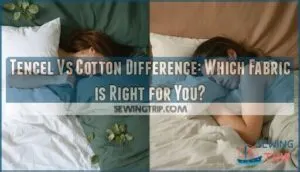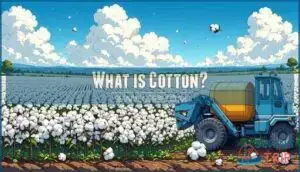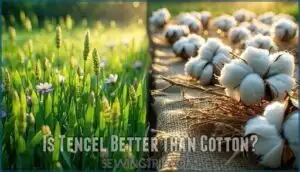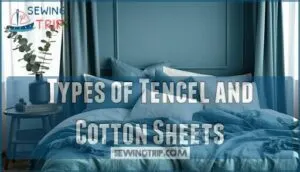This site is supported by our readers. We may earn a commission, at no cost to you, if you purchase through links.

Tencel feels silky-smooth and breathable, wicking moisture like a champion athlete, while cotton offers that familiar, cozy embrace you’ve known since childhood.
Tencel’s eucalyptus-derived fibers naturally resist bacteria and regulate temperature, making hot sleepers feel like they’ve found their holy grail.
Cotton, especially percale weaves, provides crisp coolness but lacks Tencel’s moisture-wicking superpowers.
If you’re a furnace at night, Tencel’s your freedom from sweaty sheets.
Cotton lovers appreciate its durability and classic comfort.
Both have their place in the bedroom kingdom, and choosing between them reveals surprising secrets about sleep quality.
Table Of Contents
Key Takeaways
- You’ll sleep cooler with Tencel – Its moisture-wicking properties absorb 50% more water than cotton and dry faster, making it perfect if you’re a hot sleeper who tosses and turns from overheating.
- Cotton wins for durability and budget – High-quality cotton can last up to 50 years with proper care and costs less upfront, while Tencel requires gentler washing and a higher initial investment.
- Tencel’s more eco-friendly – It uses 20 times less water than cotton production and recycles 99% of its solvents through closed-loop manufacturing, versus cotton’s heavy pesticide and water usage.
- You’ll feel the texture difference immediately – Tencel has a silk-like smoothness right out of the package, while cotton feels more familiar and cozy but varies in softness depending on the weave and processing.
What is Tencel?
Beyond the typical cotton sheets you know, Tencel fabric represents a breakthrough in sustainable textiles that’s transforming bedding.
This innovative material starts as wood pulp from responsibly harvested eucalyptus trees, which undergoes a revolutionary eco production process to create lyocell fiber.
From tree to textile—eucalyptus becomes tomorrow’s bedding through innovative green manufacturing.
Unlike traditional manufacturing, Tencel production uses a closed-loop system that recycles 99% of its solvents—think of it as nature’s own recycling program.
The wood pulp dissolves in a non-toxic solution, gets extruded through tiny holes, and emerges as silky-smooth fibers ready for spinning into yarn.
What sets Tencel apart from other natural fibers? Its moisture-wicking capabilities surpass cotton by miles, making it feel cool against your skin.
The lyocell fiber structure naturally resists bacteria while maintaining incredible softness.
Plus, those eucalyptus trees grow rapidly without pesticides, making Tencel benefits extend beyond comfort to environmental responsibility.
You’re basically sleeping on tomorrow’s textile technology.
What is Cotton?
Cotton stands as the world’s most popular natural fiber, harvested from the fluffy seed pods of cotton plants through carefully timed picking methods.
This versatile cotton fabric comes from fiber sources spanning over 80 countries, with Upland cotton comprising 90% of global production and premium Egyptian cotton representing luxury quality.
Cotton production begins when farmers harvest the white bolls using mechanical pickers or hand-picking techniques.
The raw cotton then undergoes ginning to separate fibers from seeds before spinning into yarn.
This process creates the foundation for various cotton weaves including percale’s crisp breathability, sateen’s silky smoothness, and flannel’s cozy warmth.
Cotton types offer distinct cotton advantages: durability lasting decades, exceptional moisture absorption, and natural breathability.
Whether you choose standard Upland varieties or splurge on long-staple Egyptian cotton, you’re investing in a time-tested material that improves with age and washing.
This material provides a unique combination of properties, making it a popular choice for various applications, with Upland cotton and Egyptian cotton being notable examples.
What Are The Key Differences Between Tencel and Cotton?
Now that you understand what cotton brings to the table, let’s examine how tencel fabric stacks up against cotton fabric in a detailed fabric comparison.
The differences between these materials run deeper than you might expect:
- Eco Friendly Production: Tencel production uses a closed-loop system recycling 99% of solvents, while cotton production consumes 16% of global insecticides and requires 20 times more water
- Fabric Softness: Tencel delivers silk-like smoothness straight from production, whereas cotton’s feel varies considerably by weave and processing
- Moisture Wicking: Tencel absorbs 50% more water than cotton and dries faster, making it superior for temperature regulation
- Breathability: Cotton’s hollow fibers provide natural airflow, but tencel’s structure offers better cooling performance for hot sleepers
- Durability Comparison: Tencel shows higher tensile strength (36-37 g/tex) and resists wrinkles, while cotton requires more maintenance but lasts decades with proper care
These performance gaps explain why manufacturers often blend both fibers—combining cotton’s affordability with tencel’s advanced moisture management creates fabrics that balance cost and comfort effectively.
For more information on tencel vs cotton sheets, consider the various types and blends available to make an informed decision.
Is Tencel Better Than Cotton?
You can’t definitively say one fiber beats the other since both excel in different areas.
Your choice depends on whether you prioritize eco-friendliness and cooling properties (Tencel) or durability and affordability (cotton).
Who Should Choose Tencel?
Athletes and hot sleepers, you’ve found your match. Tencel fabric absorbs and releases moisture 50% more efficiently than cotton, keeping you dry during intense workouts or restless nights.
This eco friendly textile from sustainable eucalyptus forests delivers silky smoothness that won’t irritate sensitive skin. Unlike cotton’s rougher texture, tencel’s naturally smooth fibers reduce friction and bacterial growth.
Perfect for athletic wear and sustainable clothing enthusiasts, these breathable materials excel in moisture management. Hot sleepers benefit from tencel’s superior cooling properties, while the sustainable fashion crowd appreciates its closed-loop production process using natural fibers.
For more information on the benefits of sustainable materials, consider the eco friendly options available in the market.
Who Should Choose Cotton?
Choosing cotton means embracing a classic fabric that’s stood the test of time.
Cotton benefits include exceptional durability – high-quality Egyptian cotton can last up to 50 years with proper care.
Budget shoppers appreciate cotton’s affordability, with options ranging from basic upland cotton to premium varieties.
The classic feel of cotton production creates versatile textures, from crisp percale to silky sateen weaves.
Cozy sleepers love cotton’s natural warmth and breathability balance.
This durable choice offers unmatched variety in weaves and price points.
Types of Tencel and Cotton Sheets
Exploring the realm of Tencel weaves and cotton blends can feel overwhelming, but understanding your textile options simplifies bedding decisions.
Each fabric type offers distinct characteristics that affect your sleep experience.
Tencel Weaves typically feature sateen construction, creating lustrous, draping sheets with excellent moisture wicking properties.
Cotton Blends provide versatility through various weaves and fiber combinations.
Consider these four essential fabric types when selecting sheet materials:
- Tencel Lyocell – Pure moisture-wicking fibers from eucalyptus with natural antibacterial properties
- Tencel Modal – Beechwood-derived fibers offering exceptional softness and color retention
- Egyptian Cotton – Long-staple fibers providing superior durability and luxurious feel
- Pima Cotton – Silky-smooth texture with enhanced strength and consistent quality
Understanding these textile options helps you match bedding to your specific comfort needs.
When shopping for Tencel products, researching Tencel sheet sets can provide valuable insights into the benefits of this fabric.
Comparing Tencel and Cotton Sheets: Pros and Cons
Now that you’ve explored different sheet materials and fabric weaves, let’s break down the real-world performance differences.
Tencel fabric excels at moisture wicking, keeping you cool during hot nights while maintaining eco friendly credentials through sustainable production.
Cotton fabric offers unmatched durability but requires more water and chemicals during manufacturing.
For sleep quality, tencel’s smooth texture suits sensitive skin, while cotton’s breathability varies by weave.
Textile care differs too – tencel needs gentle washing, cotton handles higher temperatures.
Both eco friendly textiles serve different needs, making your choice depend on priorities like cooling comfort versus long-term value in soft clothing applications.
When considering eco-friendly options, the quality of tencel sheets can substantially impact your decision.
Which is Better: Tencel or Cotton?
Determining which fabric reigns supreme depends on your priorities and lifestyle needs.
Tencel fabric excels in moisture management, absorbing 50% more than cotton fabric while maintaining breathability matters for hot sleepers.
Cotton offers unmatched durability and versatility across different weaves.
Consider these factors when choosing:
- Eco friendly textiles: Tencel uses 20 times less water than conventional cotton, supporting sustainable fashion goals
- Fabric softness: Tencel delivers immediate silkiness, while cotton develops softness through repeated washing cycles
- Textile innovation: Both materials offer fabric differences in performance, with Tencel providing superior moisture-wicking and cotton offering time-tested reliability
The choice between Tencel and cotton also involves understanding the cotton vs microfiber differences that impact your decision.
Your choice hinges on whether you value textile sustainability and cooling properties or prefer proven durability and cost-effectiveness.
Frequently Asked Questions (FAQs)
What’s the difference between Tencel and bamboo sheets?
Sweet dreams aren’t just made of cotton anymore.
Tencel’s eucalyptus-derived lyocell uses closed-loop processing, while bamboo viscose requires harsh chemical conversion.
Both offer silky textures and moisture-wicking, but Tencel’s production recycles 99% of solvents versus bamboo’s potentially toxic processing methods.
Does Tencel shrink like cotton?
Tencel typically shrinks less than cotton because its fiber structure remains more stable during washing. You’ll see minimal shrinkage with proper care, unlike cotton which can shrink substantially.
What is the best material for hot sleepers?
Are you tossing and turning each night in a sweaty tangle of sheets?
Tencel’s superior moisture-wicking properties and temperature regulation make it the top choice for hot sleepers, outperforming cotton’s heat-retaining tendencies.
Can I tumble dry Tencel?
You can tumble dry Tencel sheets on low heat, but air-drying preserves their softness and extends lifespan. High temperatures break down lyocell fibers, causing shrinkage and reduced moisture-wicking performance.
Is Tencel natural or synthetic?
Neither fully natural nor synthetic, Tencel exists in between—it’s a semi-synthetic fiber made from natural eucalyptus wood pulp that’s chemically processed into textile fibers through advanced manufacturing.
Is Tencel a good quality fabric?
Yes, Tencel’s a high-quality fabric you’ll appreciate. It’s engineered with superior moisture-wicking properties, antimicrobial resistance, and exceptional softness that outperforms traditional materials in comfort and durability metrics.
Is Tencel or cotton cooler?
Tencel’s superior moisture-wicking properties and temperature regulation make it substantially cooler than cotton. You’ll stay drier and more comfortable since Tencel actively pulls sweat away from your skin.
How do Tencel and cotton feel different?
You’ll feel cotton’s rougher texture and absorbent quality, while Tencel offers silky smoothness that glides against your skin. Cotton provides structure; Tencel drapes luxuriously with less friction.
Can you wash Tencel sheets like cotton?
Machine washing works fine for both fabrics, but you’ll want to use cool water and gentle cycles.
Tencel’s delicate fibers need extra care—skip the bleach and high heat to prevent shrinkage and maintain that silky feel.
Do Tencel sheets shrink after washing?
Ah, the shrinkage conspiracy strikes again!
Don’t panic though – Tencel’s engineered fibers resist the dramatic shrinkage that haunts cotton nightmares.
You’ll see minimal shrinkage (2-3%) with proper care, unlike cotton’s notorious disappearing act.
Conclusion
When the rubber meets the road, the tencel vs cotton difference comes down to your sleep priorities.
Tencel’s moisture-wicking properties and temperature regulation make it ideal for hot sleepers who need cooling relief.
Cotton offers durability and familiar comfort that’s stood the test of time.
Your choice depends on whether you prioritize advanced fiber technology or traditional reliability.
Both fabrics deliver quality sleep experiences when matched to your specific needs and preferences.
- https://learn.eartheasy.com/guides/tencel-clothing/
- https://en.wikipedia.org/wiki/Cotton
- https://www.greenstory.io/blogs/tencel-vs-bamboo-linen-and-organic-cotton-how-does-it-compare-to-other-sustainable-materials
- https://wolk-antwerp.com/pages/tencel
- https://www.sleepfoundation.org/best-sheets/tencel-vs-cotton-sheets










